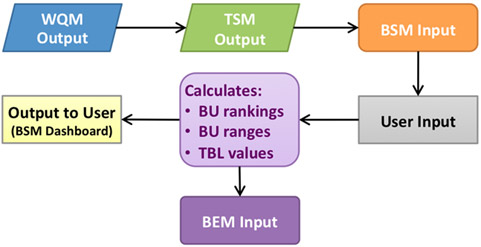Beneficial Use Screening Module
Summary
The purpose of the Beneficial Use Screening Module (BSM) is to help produced water generators, potential beneficial users, and other stakeholders identify key issues regarding different potential beneficial use projects. The user inputs information about water quantity, reliability and duration of flows for a potential project. Based on this information, the module screens potential beneficial uses and ranks them qualitatively. The rankings are output in a Screening Matrix, which provides a color-coded assessment of the feasibility and relative complexity between beneficial use categories. This can help the user to identify the top 2 or 3 beneficial uses that have a greater potential for feasibility or economic return. The user then can focus on these beneficial uses for additional assessment in the BEM.
BSM Flowchart

User Input
The user inputs the information about the water quality, supply timing and reliability, and duration of supply for a project’s produced water. For each category, the user chooses one of several options (referred to as bins in this module) from a drop down menu for the specific project:
- Water Quality
- Bin 1: Base flow < 1,000 gal/day
- Bin 2: 1,000 gal/day < Base flow < 10,000 gal/day
- Bin 3: 10,000 gal/day < Base flow < 0.1 MGD
- Bin 4: 0.1 MGD < Base flow < 1 MGD
- Bin 5: 1 MGD < Base flow < 5 MGD
- Bin 6: Base flow > 5 MGD
- Supply Timing and Reliability
- Bin 1: Intermittent flow subject to stoppage
- Bin 2: Intermittent flow for 5 years
- Bin 3: Consistent base flow for 1 year
- Bin 4: Consistent base flow for 5 years
- Bin 5: Consistent base flow for 30 years
- Duration of Supply
- Bin 1: Guaranteed base flow less than 5 years
- Bin 2: Guaranteed base flow for at least 5 years
- Bin 3: Guaranteed base flow for at least 30 year
The user can also weigh the categories to note if one category is more or less important than another. This information is run through the screening analysis to produce the Screening Matrix.
Analysis – Screening
The BSM screening evaluation is based on a qualitative ranking of the relative feasibility of each beneficial use category based on the ranges selected by the user for each screening criteria. This information is input into the Screening Matrix worksheet to assess the feasibility of each beneficial use based on the User specified bins and the relative importance of each criterion.
For example, for the relative feasibility of the Surface Water Discharge/ Instream Flow Augmentation category is evaluated in the following manner for each screening criteria:
- Water Quality – flows less than 1 MGD (Bins 1-3) are assumed to be most feasible (5) as these small flows can be more easily absorbed by the naturally occurring flow in a stream. Whereas a larger quantity of flow, 1 to 5 MGD (Bins 4-5) would need a higher flow receiving water to provide sufficient dilution and avoid creation of a stream with produced water dominated flow.
- Supply Timing and Reliability – Intermittent and unreliable flows have the potential to create unfavorable environmental conditions as habitat created by the additional flows would be difficult to sustain when flows cease, therefore Bins 1-2 are least favorable for this criterion. Guaranteed base flows up to 5 years (Bins 3-4) would be slightly more feasible, but could similarly create unfavorable environmental conditions once produced water contributions cease. Guaranteed base flows for over 30 years (Bin 5) would be the most favorable for creating and sustaining habitat. Storage of produced water can increase the feasibility of supply timing and reliability by providing a means to capture peak flows and provide a more consistent base flow or a controlled seasonal 'pulse' release that is timed to support a specific environmental period (such as fish migration).
- Duration of Supply – Guaranteed base flows less than 5 years have the potential to create unfavorable environmental conditions as habitat created by the additional flows would be difficult to sustain when flows cease, therefore Bin 1 is not very favorable for this criterion. Guaranteed base flows for at least 5 years (Bin 2) are slightly more favorable in terms of providing a longer-term supply. It follows that guaranteed base flows for at least 30 years (Bin 3) would be the most favorable as created habitat could be sustained for an extended period.
Output – Dashboard
The following is an example Dashboard based on Water Quality Bin 1, Supply Timing and Reliability Bin 1, and Duration of Supply Bin 1, all weighted equally important.
In this example, Environmental Restoration/Impoundment receives the highest score of 3.7 and is therefore the most feasible option. Potable Use, with the lowest score of 1.0, is the least feasible option.
In addition to the Dashboard rankings, the BSM also outputs the following information for each beneficial use category:
- Treatment processes for each beneficial use (from TSM);
- Associated costs, energy requirements, and useful life for the treatment processes; and
- Potential non-economic benefits of each beneficial use.
How does this module relate to other modules in the tool?
WQM – The WQM provides inputs for the TSM but does not directly interact with the BSM.
TSM – Results from the TSM are directly input into the Screening Matrix worksheet to provide the user with a range of complexity and costs for the treatment processes selected for each beneficial use category.
BEM – The BSM helps the user to identify the top 2 or 3 beneficial uses to further asses in the economic evaluation. Information in the Potential Benefits worksheet is also referenced in the BEM.
For more information, please refer to the User Manual.
